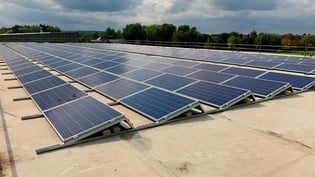Demand for warehouse space in the UK is booming this year, as more of us turn to online shopping while the virus keeps us away from the high streets. The proportion of retail done online (which was already on the rise) has skyrocketed:
Source: ONS.
More online sales means more warehouse space. And for those who run logistics, storage and distribution centres, energy use is a key consideration. We believe warehouses can benefit from solar panels to meet their increasing energy demands in a clean and sustainable way.
Energy use in warehouses
In the UK, warehouses have one of the lowest energy intensities of any non domestic buildings, with a median electricity intensity of 30kWh/m2.
But for each property, the demand can still be significant. Here is the energy usage breakdown for an average 15,000m2 warehouse (with no refrigeration):
Source: Carbon Trust.
As a large proportion of energy consumption is electric, solar PV is a great way to meet this demand.
Benefits of solar
For warehousing and logistics premises, the main benefits of solar energy are:
- financial savings - cutting your electricity bill;
- energy independence - become less reliant on the grid and more insulated against price hikes;
- sustainability - meet green criteria and improve your public image.
Depending on the hours you operate, it might be worth considering a time of use tariff. You could then displace more expensive electricity with solar in the day, and enjoy cheaper off-peak energy at night. This is great if you need to charge equipment, such as electric forklifts, overnight.
Other technologies
As we saw from the energy usage breakdown above, the vast majority is used for lighting. Therefore there are major savings to be made from switching to efficient LED lighting, as well as automated controls like occupancy detection and daylight harvesting.
Through our partnership with ECI Energy, we offer LED lighting as a service. If you have at least 100 lights to be upgraded to LED, this can be done at no upfront expense, with the cost paid back from a proportion of bill savings over 5 years. This works well for high lighting users like warehouses, particularly if they operate 24 hours a day.
Process
If all south-facing commercial rooftops were used for solar, they could generate 50% of the UK’s electricity demand, according to an estimate from the Solar Trade Association.
The complication is, of course, that many commercial buildings are rented. So to install solar PV, you need a contractual agreement between the occupier, building owner, and system owner (if using a PPA - see below).
For commercial projects, there are a few financing options available:
- Solar PPAs - a power purchase agreement where an investor funds the solar installation and sells the generated electricity to the site owner at a fixed price below grid cost.
- Lease finance - an investor funds the purchase of solar PV and rents it to the site owner, with the option to transfer ownership at the end of the lease.
We can help organise the financing side of your solar project, as well as designing and installing the system. The first step is to get in touch to discuss your circumstances. We can then do a desktop survey of the property to scope out its suitability for solar, followed by a site visit to sure up our quote.
Every stage of the process, from initial contact to design and installation, is managed by our in house team.
If you would like to discuss installing solar at your site, please give us a call on 0118 951 4490 or request a quote:
Case studies
We’ve completed many installations at factories and warehouses across the country. Here are a few of our favourites:
|
|
|
|
A PPA funded PV system for Berkeley’s new modular homes factory in Kent. |
A 300m2 solar system in Watford with only a seven year payback. |
|
|
 |
|
A 464 panel system for Oxford City Council, with estimated 90% on site usage. |
Another solar PV system to generate clean energy for Oxford City Council. |













